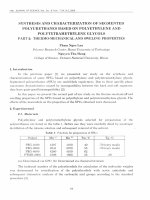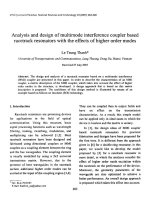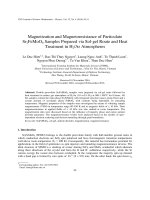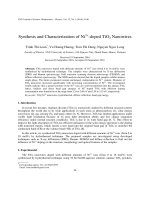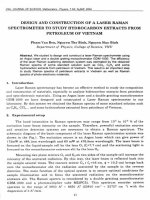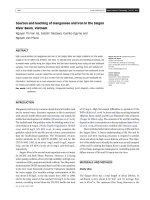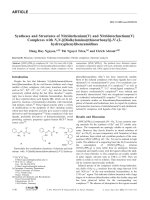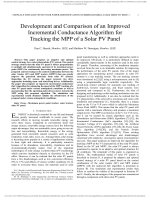DSpace at VNU: Isolation and identification of antiplatelet aggregatory principles from the leaves of Piper lolot
Bạn đang xem bản rút gọn của tài liệu. Xem và tải ngay bản đầy đủ của tài liệu tại đây (142.02 KB, 7 trang )
9436
J. Agric. Food Chem. 2007, 55, 9436–9442
Isolation and Identification of Antiplatelet
Aggregatory Principles from the Leaves of
Piper lolot
CHIA-YING LI,† WEI-JERN TSAI,‡ AMOORU GANGAIAH DAMU,† E-JIAN LEE,§
TIAN-SHUNG WU,*,†,‡ NGUYEN XUAN DUNG,⊥ TRAN DINH THANG,| AND
LE THANH#
Department of Chemistry, National Cheng Kung University, Tainan, Taiwan; National Research
Institute of Chinese Medicine, Taipei, Taiwan; Neurophysiology Laboratory, Neurosurgical Service,
Department of Surgery and Anesthesiology, National Cheng Kung University Medical Center and
Medical School, Tainan, Taiwan; Faculty of Chemistry, College of Natural Sciences, Hanoi National
University, 19-Le Thanh Tong Street, Hanoi, Vietnam; Faculty of Chemistry, Vinh University,
182-Le Duan, Vinh City, Nghean Province, Vietnam; and Faculty of Chemistry, Hue University,
47-Le Loi Street, Hue, Vietnam
The methanolic extract of Piper lolot, having shown potent inhibitory activity on platelet aggregation
induced by arachidonic acid (AA) and platelet activating factor (PAF), was subjected to activity-guided
isolation to yield twelve new amide alkaloids, piperlotine A–L (1–12), along with twenty-nine known
compounds. Their structures were elucidated on the basis of spectroscopic analysis. The isolated
compounds were tested for their inhibitory activity on the rabbit platelet aggregation. The compounds
piperlotine A (1), piperlotine C (3), piperlotine D (4), piperlotine E (5), 3-phenyl-1-(2,4,6-trihydroxyphenyl)propan-1-one (21), 3-(4-methoxyphenyl)-1-(2,4,6-trihydroxyphenyl)propan-1-one (22), 1-transcinnamoylpyrrolidine (24), sarmentine (26), pellitorine (27), methyl 3-phenylpropionate (32), and (10S)10-hydroxypheophorbide a methyl ester (40) showed potent antiplatelet aggregation activity.
KEYWORDS: Piper lolot; Piperaceae; antiplatelet aggregation; piperlotine
INTRODUCTION
Platelet aggregation plays a central role in thrombosis (clot
formation). The presence of a thrombus in an artery providing
blood to the heart is the most common cause of acute coronary
syndromes such as myocardial infarction and angina. Inhibitors
of aggregation can provide protection against these diseases and
lower vascular disease mortality and stroke incidence in patients
with unstable ischemic heart disease (1, 2). Natural antithrombotic agents that influence platelet function are of potential
interest for primary prevention of cardiovascular disease. In the
course of our continuing search for novel antiplatelet aggregatory
agents from natural sources (3–6), we found that the methanol
extract of the leaves of Piper lolot displayed antiplatelet
aggregation activity.
The genus Piper belongs to the Piperaceae family, widely
distributed throughout the tropical and subtropical regions of
* To whom correspondence should be addressed. Telephone: 8866-2747538. Fax: 886-6-2740552. E-mail:
†
National Cheng Kung University.
‡
National Research Institute of Chinese Medicine.
§
National Cheng Kung University Medical Center and Medical
School.
⊥
Hanoi National University.
|
Vinh University.
#
Hue University.
the world, and encompasses over 700 species. Members of the
Piper genus are of commercial, economical, and medicinal
importance. Economically, the Piperaceae is employed for the
production of pepper in worldwide spice markets. Plants from
the genus Piper have been used for a number of practical
applications, including remedies in many traditional medicinal
systems, such as traditional Chinese medicine, the Indian
Ayurvedic system, and folklore medicines of Latin America and
the West Indies. Piper species have been extensively investigated as a source of new natural products with potential
antitumoral, antimicrobial, antifungal, antiplatelet aggregation,
and insecticidal activities (7–13). The phytochemical profile in
Piper species is characterized by the production of typical
classes of compounds such as amides, alkaloids, benzoic acids,
lignans, neolignans, and a few flavones and chalcones (9–12,
14–18). P. lolot is a small shrub found widely at lower elevations
in Vietnam and often used to flavor meat in Southeast Asian
dishes. It has been used to treat various diseases such as
rheumatism, lumbago, digestive troubles, vomiting, diarrhea,
and others (13, 15). This species has not been the subject of
thorough phytochemical analysis, and a methanolic extract of
the leaves showed sufficient potent inhibitory activity on platelet
aggregation induced by arachidonic acid (AA) and platelet
activating factor (PAF) to warrant bioassay-guided fractionation.
10.1021/jf071963l CCC: $37.00 2007 American Chemical Society
Published on Web 10/18/2007
Antiplatelet Aggregatory Principles from Piper lolot
This led to the isolation of twelve hitherto undescribed amide
derivatives (1–12) as well as twenty-nine known compounds.
We describe herein the isolation, structural determination, and
antiplatelet aggregation activity of isolated compounds.
MATERIALS AND METHODS
Equipment. Melting points were measured on a Yanagimoto MPS3 micro melting point apparatus and are uncorrected. The UV spectra
were recorded on a Hitachi UV-3210 spectrophotometer in MeOH
solution. The IR spectra were measured on a Shimadzu FTIR-8501
spectrophotometer as KBr disks. The 1H NMR (400 MHz) and 13C
NMR (100 MHz) spectra were recorded on a Varian-400 Unity Plus
spectrometer. Chemical shifts are shown in δ values with tetramethylsilane as an internal reference. The mass spectra were performed in
the EI mode on a VG70-250S mass spectrometer.
Plant Material. The leaves of Piper lolot were collected from
Vietnam in 2004 and verified by Prof. N. X. Dung. A voucher specimen
(NXDUNG20040729) was deposited in the Herbarium of Hanoi
National University, Hanoi, Vietnam.
Extraction and Separation. The leaves of Piper lolot (4.3 kg) were
powdered and soaked with MeOH (5 L × 5) at room temperature, and
the combined extracts were concentrated under reduced pressure to give
a deep brown syrup (460 g). This was partitioned between H2O and
CHCl3. The CHCl3 layer (95 g, after evaporation of the solvent) was
directly chromatographed on a silica gel column by elution with a
gradient of CHCl3/Me2CO to afford eleven fractions. Fraction 3
underwent column chromatographic separation over silica gel using
n-hexane/EtOAc (19:1) as an eluent to yield 22 (17.2 mg) and 37 (1.1
mg). Fraction 5 was rechromatographed on a silica gel column and
eluted with n-hexane/Me2CO (9:1) to give 18 (2.1 mg), 19 (10.8 mg),
21 (7.2 mg), 23 (2.1 mg), 22 (426.5 mg), 32 (2.4 mg), 33 (1.1 mg), 34
(4.3 mg), and 38 (5.5 mg). Fraction 8 was chromatographed on silica
gel and eluted with n-hexane/diisopropyl ether (2:1) to afford 26 (5.3
mg), 27 (6.2 mg), 31 (6.5 mg), 41 (7.3 mg), 5 (4.1 mg), 6 (5.3 mg), 7
(1.1 mg), and 8 (0.9 mg), successively. Fraction 9 underwent column
chromatographic separation over silica gel using n-hexane/EtOAc
(6:1) as an eluent to yield 13 (3.7 mg), 14 (2.1 mg), 15 (2.1 mg), 16
(0.4 mg), 24 (12.6 mg), 25 (1.1 mg), 1 (5.2 mg), 2 (1.3 mg), 30 (1.5
mg), 29 (0.7 mg), 3 (19.6 mg), 4 (2.3 mg), 9 (1.1 mg), and 12(1.4
mg), successively. Fraction 11 was chromatographed on silica gel and
eluted with CHCl3/EtOAc (6:1) to afford 20 (8.9 mg), 17 (0.7 mg), 28
(0.6 mg), 40 (2.2 mg), 10 (0.9 mg), 11 (1.6 mg), 35 (0.7 mg), 39 (1.2
mg), and 36 (2.3 mg), successively.
Piperlotine-A (1). Colorless syrup. HREIMS m/z 231.1255 [M]+
(calcd for C14H17NO2, 231.1259). UV λmax (MeOH) nm: 225, 300. IR
ν (KBr) cm-1: 828, 1030, 1173, 1250, 1439, 1511, 1600, 1647, 2955.
1
H NMR (400 MHz, CDCl3): δ 7.59 (2H, dd, J ) 7.2, 1.6 Hz, H-2′,
6′), 7.52 (1H, d, J ) 15.2 Hz, H- ), 6.95 (2H, dd, J ) 7.2, 1.6 Hz,
H-3′, 5′), 6.82 (1H, d, J ) 15.2 Hz, H-R), 3.82 (3H, s, 4′-OMe), 3.66
(2H, t, J ) 6.4 Hz, H-2), 3.44 (2H, t, J ) 6.8 Hz, H-5), 1.99 (2H, m,
H-3), 1.85 (2H, m, H-4). 13C NMR (100 MHz, CDCl3): δ 165.7, 161.4,
141.9, 129.9, 128.6, 117.0, 114.7, 55.7, 46.9, 46.3, 26.4, 24.6. EIMS
(% rel intensity), m/z 231 [M]+ (35), 161 (100), 133 (20).
Piperlotine-B (2). Colorless syrup. HREIMS m/z 231.1263 [M]+
(calcd for C14H17NO2, 231.1259). UV λmax (MeOH) nm: 215, 273. IR
ν (KBr) cm-1: 1029, 1173, 1254, 1444, 1511, 1603, 1638, 2920. 1H
NMR (400 MHz, CDCl3): δ 7.39 (2H, d, J ) 8.8 Hz, H-2′, 6′), 6.83
(2H, d, J ) 8.8 Hz, H-3′, 5′), 6.55 (1H, d, J ) 12.4 Hz, H- ), 5.94
(1H, d, J ) 12.4 Hz, H-R), 3.80 (3H, s, 4′-OMe), 3.52 (2H, t, J ) 6.4
Hz, H-2), 3.22 (2H, t, J ) 6.0 Hz, H-5), 1.83–1.74 (4H, m, H-3, 4).
EIMS (% rel intensity), m/z 231 [M]+ (42), 161 (100), 133 (18).
Piperlotine-A (3). White powder. Mp: 148–150 °C. HREIMS m/z
291.1473 [M]+ (calcd for C16H21NO4, 291.1470). UV λmax (MeOH)
nm: 231, 304. IR ν (KBr) cm-1: 1007, 1125, 1332, 1418, 1452, 1505,
1584, 1647, 2968. 1H NMR (400 MHz, acetone-d6): δ 7.48 (1H, d, J
) 15.2 Hz, H- ), 6.98 (2H, s, H-2′, 6′), 6.90 (1H, d, J ) 15.2 Hz,
H-R), 3.86 (6H, s, 3′-OMe, 5′-OMe), 3.74 (3H, s, 4′-OMe), 3.65 (2H,
t, J ) 6.8 Hz, H-2), 3.44 (2H, d, J ) 6.8 Hz, H-5), 1.96 (2H, m, H-3),
1.85 (2H, m, H-4). 13C NMR (100 MHz, acetone-d6): δ 163.9, 153.9,
J. Agric. Food Chem., Vol. 55, No. 23, 2007
9437
140.9, 139.9, 131.4, 119.3, 105.7, 59.9, 55.8, 46.3, 45.7, 26.1, 24.3.
EIMS (% rel intensity), m/z 291 [M]+ (43), 261 (41), 221 (86), 191
(100), 161 (43).
Piperlotine-D (4). Colorless syrup. HREIMS m/z 291.1466 [M]+
(calcd for C16H21NO4, 291.1470). UV λmax (MeOH) nm: 226, 289. IR
ν (KBr) cm-1: 1005, 1124, 1330, 1417, 1582, 1648, 2942. 1H NMR
(400 MHz, acetone-d6): δ 6.90 (2H, s, H-2′, 6′), 6.53 (1H, d, J ) 12.4
Hz, H- ), 6.02 (1H, d, J ) 12.4 Hz, H-R), 3.74 (6H, s, 3′-OMe, 5′OMe), 3.72 (3H, s, 4′-OMe), 3.44 (2H, m, H-2), 3.30 (2H, m, H-5),
1.83 (4H, m, H-3, 4). EIMS (% rel intensity), m/z 291 [M]+ (70), 221
(100), 191 (15).
Piperlotine-E (5). Colorless syrup. HREIMS m/z 215.0951 [M]+
(calcd for C13H13NO2, 215.0946). UV λmax (MeOH) nm: 229, 235 (sh).
IR ν (KBr) cm-1: 742, 1224, 1465, 1513, 1710, 2926, 3355. 1H NMR
(400 MHz, acetone-d6): δ 8.16 (1H, s, 4′-OH), 7.42 (2H, m, H-2, 5),
7.12 (2H, d, J ) 8.4 Hz, H-2′, 6′), 6.76 (2H, d, J ) 8.4 Hz, H-3′, 5′),
6.26 (2H, m, H-3, 4), 3.20 (2H, t, J ) 8.0 Hz, H-R), 2.95 (2H, t, J )
8.0 Hz, H- ). 13C NMR (100 MHz, acetone-d6): δ 170.2, 156.0, 131.6,
129.6, 119.2, 115.4, 112.7, 36.3, 29.5. EIMS (% rel intensity), m/z 215
[M]+ (60), 148 (25), 120 (33), 107 (100).
Piperlotine-F (6). Colorless needles. Mp: 101–102 °C. HREIMS
m/z 215.0941 [M]+ (calcd for C13H13NO2, 215.0946). UV λmax (MeOH)
nm: 211, 273. IR ν (KBr) cm-1: 974, 1355, 1409, 1539, 1659, 1728,
2923. 1H NMR (400 MHz, CDCl3): δ 7.95 (1H, d, J ) 15.8 Hz, H- ),
7.84 (1H, d, J ) 15.8 Hz, H-R), 7.61 (2H, m, H-2′, 6′), 7.38 (3H, m,
H-3′, 4′, 5′), 3.93 (2H, t, J ) 7.2 Hz, H-5), 2.66 (2H, t, J) 6.8 Hz,
H-3), 2.08 (2H, m, H-4). 13C NMR (100 MHz, CDCl3): δ 175.7, 166.3,
144.0, 134.4, 129.2, 128.3, 128.3, 119.0, 45.8, 33.6, 17.2. EIMS (%
rel intensity), m/z 215 [M]+ (7), 149 (29), 131 (100), 103 (39).
Piperlotine-G (7). Colorless needles. Mp: 140–142 °C. HREIMS
m/z 245.1048 [M]+ (calcd for C14H15NO3, 245.1052). UV λmax (MeOH)
nm: 222, 284. IR ν (KBr) cm-1: 1025, 1177, 1248, 1348, 1514, 1600,
1662, 1730, 2936. 1H NMR (400 MHz, acetone-d6): δ 7.85 (1H, d, J
) 16.0 Hz, H- ), 7.71 (1H, d, J ) 16.0 Hz, H-R), 7.69 (2H, d, J ) 7.2
Hz, H-2′, 6′), 7.00 (2H, d, J ) 7.2 Hz, H-3′, 5′), 3.85 (3H, s, 4′-OMe),
3.82 (2H, m, H-5), 2.61 (2H, m, H-3), 2.06 (2H, m, H-4). EIMS (%
rel intensity), m/z 245 [M]+ (44), 161 (100), 133 (17).
Piperlotine-H (8). Colorless syrup. HREIMS m/z 245.1050 [M]+
(calcd for C14H15NO3, 245.1052). UV λmax (MeOH) nm: 224, 274. IR
ν (KBr) cm-1: 1030, 1176, 1252, 1350, 1601, 1658, 2923. 1H NMR
(400 MHz, acetone-d6): δ 7.61 (2H, d, J ) 8.0 Hz, H-2′, 6′), 6.87 (2H,
d, J ) 8.0 Hz, H-3′, 5′), 6.85 (1H, d, J ) 12.8 Hz, H- ), 6.80 (1H, d,
J ) 12.8 Hz, H-R), 3.82 (2H, m, H-5), 3.82 (3H, s, 4′-OMe), 2.57
(2H, m, H-3), 2.06 (2H, m, H-4). EIMS (% rel intensity), m/z 245 [M]+
(33), 178 (15), 161 (75), 153 (44), 136 (39), 107 (53), 77 (100).
Piperlotine-I (9). Colorless syrup. [R]: +23.2 (MeOH; c 0.08).
HREIMS m/z 231.1255 [M]+ (calcd for C14H17NO2, 231.1259). UV
λmax (MeOH) nm: 210, 216, 222, 274. IR ν (KBr) cm-1: 1052, 1129,
1341, 1449, 1548, 1657, 2930. 1H NMR (400 MHz, acetone-d6): δ
7.56 (2H, m, H-2′, 6′), 7.52 (1H, d, J ) 15.6 Hz, H- ), 7.39 (3H, m,
H-3′, 4′, 5′), 6.65 (1H, d, J ) 15.6 Hz, H-R), 4.37 (1H, t, J ) 5.2 Hz,
H-2), 3.30 (2H, m, H-5), 3.26 (3H, s, 2-OMe), 1.80 (4H, m, H-3, 4).
13
C NMR (100 MHz, acetone-d6): δ 164.4, 139.2, 135.7, 129.4, 129.0,
127.7, 122.4, 104.4, 52.2, 39.0, 30.1, 25.0. EIMS (% rel intensity),
m/z 231 [M]+ (11), 131 (100), 103 (32), 77 (23).
Piperlotine-J (10). Colorless syrup. HREIMS m/z 277.1310 [M]+
(calcd for C15H19NO4, 277.1314). UV λmax (MeOH) nm: 212, 218, 223,
280. IR ν (KBr) cm-1: 977, 1236, 1429, 1587, 1645, 1733, 2928, 3371.
1
H NMR (400 MHz, CD3OD): δ 7.62 (2H, m, H-2′, 6′), 7.60 (1H, d,
J ) 15.6 Hz, H- ), 7.39 (3H, m, H-3′, 4′, 5′), 6.96 (1H, d, J ) 15.6
Hz, H-R), 5.40 (1H, m, H-3), 3.95 (2H, m, H-1), 3.85 (2H, m, H-4),
2.17 (2H, m, H-2), 2.05 (3H, s, OAc). 13C NMR (100 MHz, CD3OD):
δ 171.0, 166.1, 142.6, 135.1, 129.8, 128.8, 128.0, 118.0, 74.1, 52.3,
44.7, 29.7, 19.7. The enantiomer: 1H NMR (400 MHz, CD3OD): δ
7.62 (2H, m, H-2′, 6′), 7.60 (1H, d, J ) 15.6 Hz, H- ), 7.39 (3H, m,
H-3′, 4′, 5′), 6.88 (1H, d, J ) 15.6 Hz, H-R), 5.33 (1H, m, H-3), 3.75
(2H, m, H-4), 3.58 (2H, m, H-1), 2.27 (2H, m, H-2), 2.04 (3H, s, OAc).
13
C NMR (100 MHz, CD3OD): δ 171.0, 166.1, 142.6, 135.1, 129.8,
128.8, 128.0, 118.1, 72.7, 51.8, 44.1, 31.3, 19.7. EIMS (% rel intensity),
m/z 217 [M – AcOH]+ (40), 199 (10), 131 (100), 103 (37), 77 (19).
9438
J. Agric. Food Chem., Vol. 55, No. 23, 2007
Li et al.
Figure 1
Piperlotine-K (11). Colorless syrup. HREIMS m/z 235.1214 [M+]
(calcd for C13H17NO3, 235.1208). UV λmax (MeOH) nm: 211, 218, 224,
280. IR ν (KBr) cm-1: 976, 1103, 1438, 1580, 1593, 1647, 2947, 3380.
1
H NMR (400 MHz, acetone-d6): δ 7.64 (2H, m, H-2′, 6′), 7.58 (1H,
d, J ) 15.6 Hz, H- ), 7.39 (3H, m, H-3′, 4′, 5′), 6.99 (1H, d, J ) 15.6
Hz, H-R), 4.54 (1H, m, H-3), 3.82 (2H, m, H-1), 3.66 (2H, m, H-4),
2.04 (2H, m, H-2). 13C NMR (100 MHz, acetone-d6): δ 164.4, 141.0,
135.8, 129.6, 129.0, 128.1, 119.8, 70.7, 54.8, 44.5, 34.5. The enantiomer: 1H NMR (400 MHz, acetone-d6): δ 7.64 (2H, m, H-2′, 6′), 7.58
(1H, d, J ) 15.6 Hz, H- ), 7.39 (3H, m, H-3′, 4′, 5′), 6.94 (1H, d, J )
15.6 Hz, H-R), 4.44 (1H, m, H-3), 3.57 (4H, m, H-1, 4), 1.93 (2H, m,
H-2). 13C NMR (100 MHz, acetone-d6): δ 164.4, 141.0, 135.8, 129.6,
129.0, 128.1, 120.0, 69.0, 54.4, 44.0, 32.9. EIMS (% rel intensity),
m/z 217 [M – H2O]+ (65), 131 (100), 103 (45), 77 (22).
Piperlotine-L (12). Colorless syrup. [R]: +42.2 (MeOH; c 0.1).
HREIMS m/z 319.1418 [M+] (calcd for C17H21NO5, 319.1420). UV
λmax (MeOH) nm: 210, 216, 222, 274. IR ν (KBr) cm-1: 979, 1043,
1232, 1547, 1621, 1660, 1736, 2935, 3283. 1H NMR (400 MHz,
CDCl3): δ 7.62 (1H, d, J ) 15.6 Hz, H- ), 7.51 (2H, m, H-2′, 6′), 7.38
(3H, m, H-3′, 4′, 5′), 6.39 (1H, d, J ) 15.6 Hz, H-R), 5.98 (1H, br,
NH), 5.11 (1H, m, H-3), 4.15 (2H, m, H-4), 3.62 (2H, m, H-1), 2.10
(3H, s, OAc), 2.06 (3H, s, OAc), 1.96 (2H, m, H-2). 13C NMR (100
MHz, CDCl3): δ 171.4, 171.2, 166.3, 141.9, 134.9, 130.0, 129.1, 128.1,
120.3, 70.7, 60.5, 43.4, 31.2, 21.3, 21.1. EIMS (% rel intensity), m/z
319 [M]+ (1), 199 (21), 161 (27), 131 (100), 103 (25), 77 (11).
Preparation of the Platelet Suspension. Washed platelet suspension
was prepared as previously described with some modifications (19–21).
In brief, blood was collected from the marginal ear vein of New Zealand
White rabbits into tubes containing one-sixth volume of acid-citratedextrose as anticoagulant. The blood was centrifuged at 1000g for 8
min at room temperature. The upper portion was kept as platelet-rich
plasma (PRP) after mixing with EDTA to a final concentration of 5
mM and recentrifuged at 2000g for 12 min. The platelet pellet was
suspended in modified Ca2+-free Tyrode′s buffer (137 mM NaCl, 2.8
mM KCl, 2 mM MgCl2, 0.33 mM NaH2PO4, 5 mM glucose, 10 mM
HEPES) with 0.35% bovine serum albumin, heparin (50 unit/mL), and
apyrase (1 unit/mL) and then was incubated at 37 °C for 20 min. After
centrifugation at 2000g for 6 min, the washed platelet pellet was
resuspended in Tyrode’s buffer containing 1 mM Ca2+. For the
aggregation test, the platelet numbers were counted by hemacytometer
and adjusted to 2.5 × 108 platelets/mL.
Measurement of Platelet Aggregation. Platelet aggregation was
measured turbidimetrically with a light-transmission Platelet Aggregation Chromogenic Kinetic System PACK4 (Helena Laboratories,
Beaumont TX) with some modifications (19–21). The platelet suspension was stirred at 900 rpm and incubated with an appropriate amount
of vehicle (dimethyl sulfoxide, DMSO) or various concentrations of
test compounds in DMSO at 37 °C for 2 min. Aggregation was induced
with PAF (5 nM) or AA (100 µM). The transmission of washed platelet
suspension was assigned 0% aggregation while transmission through
Tyrode′s buffer was assigned 100% aggregation. The extent of platelet
aggregation was measured as the maximal increase in light transmission
within 4 min after the addition of an inducer. To eliminate or minimize
any possible effects of the solvent, the final concentration of DMSO
in the platelet suspension was fixed at 0.5%.
RESULTS AND DISCUSSION
Extraction of the leaves of P. lolot with MeOH followed by
liquid–liquid partition resulted in the localization of the antiplatelet activity in the chloroform fraction. Further fractionation
on a silica gel column yielded fractions rich in a mixture of
amide derivatives. These fractions were subjected to further
chemical analysis to give twelve amide derivatives (1–12)
(Figure 1) and twenty-nine known compounds.
Piperlotine-A (1) was isolated as colorless syrup and had a
HREIMS molecular ion peak indicating a molecular formula
of C14H17NO2. The UV absorption maxima at 225 and 300 nm
coupled with the IR bands at 1647 cm-1 indicated the presence
of an E-cinnamoyl amide system. In the 1H NMR of 1, AB
type proton signals at δ 7.59 (1H, dd, J ) 7.2, 1.6 Hz, H-2′/6′)
and 6.95 (2H, dd, J ) 7.2, 1.6 Hz, H-3′/5′), conjugated trans
double bond proton signals at δ 7.52 and 6.82 (each 1H, d, J )
15.2 Hz), and a methoxyl signal at δ 3.82 (3H, s) were consistent
with a p-methoxy-E-cinnamoyl moiety. Additional signals for
the presence of a pyrrolidine moiety were indicated by signals
of the four mutually coupled methylene groups at δ 3.66 (2H,
t, J ) 6.4 Hz, H-2), 3.44 (2H, t, J ) 6.8 Hz, H-5), 1.99 (2H, m,
H-3), and 1.85 (2H, m, H-4). With the basic fragments of 1
established, the connectivities between them were solved by
the use of HMBC and NOESY correlations. On the basis of
the above evidence, the structure of 1 was assigned as
(4-methoxy-E-cinnamoyl)pyrrolidine. To the best of our knowledge, this is the first report of (4-methoxy-E-cinnamoyl)pyrrolidine from a natural source. However, the title compound has
been prepared during the synthesis of its diaziridine derivative
by Ishihara et al. (22).
Piperlotine-B (2), isolated as a colorless syrup, showed the
same molecular formula of C14H17NO2 as 1 by HREIMS. When
Antiplatelet Aggregatory Principles from Piper lolot
comparing the 1H NMR spectrum of 2 with that of 1, the signals
were superimposable except for the signals due to H-R and H- ,
which suggested these two compounds may be geometrical
isomers sharing the same structural features. The signals due
to H-R and H- of the conjugated carbonyl system resonated
at δ 6.55 (1H, d, J ) 12.4 Hz, H- ) and 5.94 (1H, d, J ) 12.4
Hz, H-R). The coupling constant indicated that the double bond
possesses Z geometry. The attribution of this configuration was
corroborated by the shielded signals of H-2′/6′ and H-3′/5′ and
fewer UV absorption maxima in the Z-isomer (273 nm) when
compared with the E-isomer (300 nm). Thus, the structure of 2
was determined as (4-methoxy-Z-cinnamoyl)pyrrolidine.
Piperlotine-C (3) was obtained as a white powder with a
molecular formula of C16H21NO4 by HREIMS. The IR spectrum
of 3 showed bands at 1647 cm–1 (conjugated carbonyl group)
and 1505, 1584 cm-1 (aromatic ring). The 1H NMR spectrum
of 3 showed typical signals for a pyrrolidine ring at δ 3.65 (2H,
t, J ) 6.8 Hz, H-2), 3.44 (2H, d, J ) 6.8 Hz, H-5), 1.96 (2H,
m, H-3), and 1.85 (2H, m, H-4). The 1H NMR spectrum also
displayed signals characteristic of a trimethoxy-E-cinnamoyl
moiety. These consisted of trans coupled olefinic protons at δ
7.48 (1H, d, J ) 15.2 Hz) and 6.90 (1H, d, J ) 15.2 Hz) for
the conjugated carbonyl system; signals for three methoxyl
groups at δ 3.86 (6H, s) and 3.74 (3H, s), two of which are
equivalent; and a shielded aromatic singlet integrating for two
protons of a symmetrically substituted aromatic ring at δ 6.98
(2H, s, H-2′/6′). The corresponding carbon signals were assigned
with the aid of the HMQC spectra. The substitution pattern of
the aromatic ring and the connection between the previously
mentioned two moieties were confirmed by the correlations
observed in the NOESY and HMBC spectra. Therefore, the
structure of 3 was established as N-(trimethoxy-E-cinnamoyl)pyrrolidine. Although 3 was reported as a synthetic product (23),
this is the first report of its occurrence in nature.
Piperlotine-D (4) was obtained as a colorless syrup and
shown to have a molecular formula of C16H21NO4. All the
spectra of 4 were similar to those of 3 and suggested that it is
an isomer of 3. The most obvious difference between the 1H
NMR spectra resulted from the presence of signals for an R, unsaturated carbonyl system with a Z-configuration in 4 at δ
6.53 (1H, d, J ) 12.4 Hz) and 6.02 (1H, d, J ) 12.4 Hz), instead
of an E-configuration in 3. Thus, 4 was identified as N(trimethoxy-Z-cinnamoyl)pyrrolidine. Bruening et al. (24) have
synthesized this compound, but this is the first report as a natural
product.
Piperlotine-E (5) was obtained as a colorless syrup. The
molecular formula of 5 was established as C13H13NO2 by
HREIMS. Its UV absorption maxima at 229 and 235 (sh) nm
were consistent with an aromatic compound. The IR absorption
bands at 3355, 1710, and 1513, 1465 cm-1 indicated the
presence of a hydroxyl, a conjugated carbonyl group of an
amide, and an aromatic ring. The 1H NMR spectrum of 5
displayed typical signals corresponding to a p-hydroxyphenyl
propanoyl moiety. These contained AB type signals at δ 7.12
(2H, d, J ) 8.4 Hz, H2′/H-6′) and 6.76 (2H, d, J ) 8.4 Hz,
H-3′/H-5′), a hydroxyl group at δ 8.16 (1H, s), and coupled
triplets for two methylenes at δ 3.20 (2H, t, J ) 8.0 Hz, H-R)
and 2.95 (2H, t, J ) 8.0 Hz, H- ). The carbon signals at δ >
170.2 (CdO), 36.3 (C-R), and 29.5 (C- ) corroborated the
presence of a propanoyl moiety in 5. In addition, a set of signals
for a pyrrole ring were also observed at δ 7.42 (2H, m, H-2, 5)
and 6.26 (2H, m, H-3, 4). Analysis of HMQC, COSY, and
HMBC data enabled the complete assignment of the signals
J. Agric. Food Chem., Vol. 55, No. 23, 2007
9439
for this compound, leading to its formulation as N-(p-hydroxyphenylpropanoyl)pyrrole.
Piperlotine-F (6) was obtained as colorless needles, mp
101–102 °C. It exhibited a molecular formula of C13H13NO2,
on the basis of its HREIMS data. Its UV absorption maxima at
211 and 273 nm indicated the presence of a cinnamoyl
chromophore in the molecule. The IR spectrum showed absorption bands corresponding to conjugated amide carbonyl (1659
cm-1), a γ-lactam (1728 cm-1), and an aromatic ring (1409,
1539 cm-1). A trans cinnamoyl moiety was apparent from the
NMR signals at δH 7.61 (2H, m) and 7.38 (3H, m), attributable
to H-2′, 6′ and H-3′, 4′, 5′, respectively, and trans coupled
olefinic protons at δH 7.95 and 7.84 (each 1H, d, J ) 15.8 Hz),
together with the carbon signals at δC 166.3 (CdO), 144.0 (C), and 119.0 (C-R). In addition, a set of signals for a pyrrolidin2-one residue were also observed at δH 3.93 (2H, t, J ) 7.2
Hz, H-5), 2.66 (2H, t, J ) 6.8 Hz, H-3), and 2.08 (2H, m, H-4),
and related carbons were observed at δC 175.7, 45.8, 33.6, and
17.2 ppm. The carbonyl at C-2 was supported by the unusual
downfield shift of the H-R signal to δH 7.84. Connectivities
between these two moieties were determined with the aid of an
HMBC experiment. Finally, the structure of 6 was deduced as
N-(E-cinnamoyl)pyrrolidin-2-one, which has been synthesized
by Soloshonok et al. (25).
Piperlotine-G (7) was isolated as a white powder, mp
140–142 °C, and shown to have a molecular formula of
C14H15NO3 on the basis of HREIMS. Its UV and IR spectra
were consistent with the presence of a cinnamoyl chromophore.
In the 1H NMR spectrum, AB type aromatic proton signals at
δ 7.69 (2H, d, J ) 7.2 Hz, H-2′, 6′) and 7.00 (2H, d, J ) 7.2
Hz, H-3′, 5′) and a methoxyl signal at δ 3.85 (3H, s), together
with the trans coupled proton signals at δ 7.85 and 7.71 (each
1H, d, J ) 16.0 Hz), indicated the presence of the pmethoxycinnamoyl moiety in 7. Besides this moiety, the 1H
NMR spectrum also showed signals due to a pyrrolidin-2-one
ring at δ 3.82 (2H, m, H-5), 2.61 (2H, m, H-3), and 2.06 (2H,
m, H-4). These data were in agreement with those reported for
the synthetic sample prepared by Sibi et al. (26). Thus, 7 was
identified as N-(p-methoxy-E-cinnamoyl)pyrrolidin-2-one, and
this is the first report from the natural source.
Piperlotine-H (8) was obtained as a colorless syrup. HREIMS
data of this compound corresponded to a molecular formula of
C14H15NO3, as in 7, indicating it to be a structural isomer.
Compound 8 and 7 were found to have similar structures by
comparison of their UV, IR, and NMR spectra. The observed
difference was the appearance of cis coupled olefinic protons
at δ 6.85 and 6.80 (each 1H, d, J ) 12.8 Hz), which indicated
that compound 8 is a Z-isomer of 7. Therefore, the structure of
8 was assigned as N-(p-methoxy-Z-cinnamoyl)pyrrolidin-2-one.
Piperlotine-I (9) was obtained as a colorless syrup. The
HREIMS of 9 was consistent with a molecular formula of
C14H17NO2. The UV absorption maxima at 274 nm suggested
the presence of a cinnamoyl residue. In the IR spectrum, bands
at 1657 and 1449, 1548 cm-1 revealed the presence of
conjugated amide carbonyl group and an aromatic ring. Accordingly, the 1H NMR spectrum displayed characteristic signals
for a cinnamoyl group (δ 7.56, 2H, m; 7.39, 3H, m; 7.52 and
6.65, each 1H, d, J ) 15.6 Hz). A methoxyl singlet at δ 3.26
and the signals at δ 4.37 (1H, t, J ) 5.2 Hz, H-2), 3.30 (2H, m,
H-5), and 1.80 (4H, m, H-3, 4), in addition to the carbon signals
in the 13C NMR spectrum at δ 52.2 and 104.4, 39.0, 30.1, and
25.0, suggested the presence of a 2-methoxypyrrolidine residue.
These structural fragments were confirmed by the analysis of
1
H–1H COSY, HMQC, and HMBC experiments. The downfield
9440
J. Agric. Food Chem., Vol. 55, No. 23, 2007
shift of C-2 to δC 104.4 suggested that the methoxyl group was
located at C-2 of the pyrrolidine ring. This was further supported
by a 3J correlation between OMe (δH 3.26) and C-2 (δC 104.4)
in the HMBC experiment. Analysis of all the available data led
us to conclude that 9 is N-cinnamoyl-2-methoxypyrrolidine.
Piperlotine-J (10) was obtained as a racemic mixture. The
HREIMS data corresponded to the molecular formula
C15H19NO4. The UV spectrum of 10 showed absorption at 280
nm, indicating it to be an aromatic compound. The IR bands at
3371, 1733, and 1645 cm-1 were consistent with the presence
of hydroxyl, ester carbonyl, and conjugated amide carbonyl
groups. The 1H NMR spectrum displayed signals for five
aromatic protons (δ 7.62 and 7.39) and a pair of olefinic protons
(δ 7.60 and 6.96, J ) 15.6 Hz), attributable to a cinnamoyl
moiety. A set of mutually coupled protons deduced with the
aid of 1H–1H COSY at δ 5.40 (1H, m, H-3), 3.95 (2H, m, H-1),
3.85 (2H, m, H-4), and 2.17 (2H, m, H-2) suggested the presence
of a 3,4-disubstituted butanol moiety. The NMR spectra showed
signals for an acetoxyl group at δH 2.05 and δC 19.7 and 171.0,
the position of which was located at C-3, due to a 3J HMBC
correlation from H-3 (δH 5.40) to the acetyl carbonyl (δC 171.0),
and a downfield shift of H-3 to δH 5.40. The HMBC spectrum
of 10 also showed a 3J correlation from H-4 (δH 3.85) to the
amide carbonyl carbon at δC 166.1, which indicated that the
cinnamoyl moiety was attached to C-4 of the 3-acetoxybutan1-ol unit by an amide linkage. Thus, the structure of 10 was
deduced to be 4-N-cinnamoyl-3-acetoxylbutanol. The other set
of signals assignable to a 4-substituted 3-acetoxylbutanol side
chain of an enantiomer of 10 appeared at δH 5.33 (1H, m, H-3),
3.75 (2H, m, H-4), 3.58 (2H, m, H-1), 2.27 (2H, m, H-2), and
2.04 (3H, s, OAc).
Piperlotine-K (11) was also obtained as a racemic mixture.
It was deduced to have an elemental composition of C13H17NO3
from its HREIMS data. The UV spectrum was similar to that
of 10, and the IR absorption bands at 3380 and 1647 cm-1
indicated the presence of hydroxyl and conjugated amide
functionalities, respectively. The NMR spectra were similar to
those of 10, except for the lack of signals for the acetyl group.
Thus, as in the case of 10, the NMR data including COSY and
HMBC information were consistent with the presence in 11 of
an E-cinnamoyl amide unit (δH 7.64, m, 2H; 7.39, m, 3H; 7.58
and 6.99, each 1H, d, J ) 15.6 Hz) linked through an amide
bond with C-4 of a 3,4-disubstituted butanol moiety (δH 4.54,
1H, m, H-3; 3.82, 2H, m, H-1; 3.66, 2H, m, H-4; 2.04, 2H, m,
H-2). However, 11 possesses at C-3 a hydroxyl group instead
of the acetyl grouping of 10, which was strongly supported by
the upfield shift of H-3 to δH 4.54. Thus, the structure of 11
was elucidated as 4-N-E-cinnamoylbutane-1,3-diol. The other
set of signals due to the 4-substituted butan-1,3-diol moiety of
an enantiomer of 11 appeared at δH 4.44 (1H, m, H-3), 3.57
(4H, m, H-1, 4), and 1.93 (2H, m, H-2).
Piperlotine-L (12) was obtained as a colorless syrup with
an elemental composition of C17H21NO5, as determined from
its HREIMS. The UV absorption maxima at 274 nm and the
IR bands at 3283, 1736, and 1660 cm-1 were similar to those
of 10 and 11. The 1H spectra revealed signals due to the transcinnamoyl amide moiety (δH 7.51, 2H, m, H-2′, 6′; 7.38, 3H,
m, H-3′, 4′, 5′; 7.62 and 6.39, each 1H, d, J ) 15.6 Hz, H-R,
- ; 5.98, 1H, br, NH) and the 4-substituted-1,3-dioxygenated
butane chain (δH 5.11, 1H, m, H-3; 4.15, 2H, m, H-4; 3.62,
2H, m, H-1; 1.96, 2H, m, H-2). These data were similar to those
of 11, except for the presence of two acetyl groups that resonated
at δH 2.10, 2.06 (each 3H, s) and δC 171.4, 171.2, 21.3, 21.1.
These two acetyl groups were placed at C-1 and C-3 on the
Li et al.
Table 1. Effect of Principles from Piper lolot on the Platelet Aggregation
Induced by Arachidonic Acid (AA) and Platelet Activating Factor (PAF)a
anti-AA
compd
1
3
4
5
6
12
14
18
20
21
22
24
26
27
31
32
34
38
40
Aspirinb
CV3988b
inhibition
(%) at 100
µg/mL
100.0
100.0
100.0
96.2
0.9
-1.2
2.2
6.8
5.3
100.0
100.0
100.0
100.0
87.4
-1.6
100.0
0.8
1.2
77.4
100.0
anti-PAF
IC50
(µg/mL)
15.2 ( 3.0
26.6 ( 5.1
43.4 ( 5.4
11.5 ( 4.6
19.0 ( 6.0
31.2 ( 1.1
7.3 ( 0.2
49.4 ( 3.4
53.0 ( 1.8
53.4 ( 1.5
38.1 ( 3.2
5.5 ( 0.9
inhibition
(%) at 100
µg/mL
13.0
29.5
2.1
74.7
3.5
7.7
-0.7
7.9
3.3
95.4
97.7
28.5
97.1
25.5
-5.3
67.0
-4.1
2.3
78.9
100.0
IC50
(µg/mL)
58.6 ( 1.4
61.0 ( 2.5
71.4 ( 7.5
52.6 ( 2.7
83.2 ( 1.3
50.3 ( 5.3
1.5 ( 0.3
a
The antiplatelet aggregation (%) was calculated by the following equation:
antiplatelet aggregation (%) ) [1 – (platelet aggregation potency of sample/platelet
aggregation potency of vehicle)] × 100%. The IC50 value of each principle was
calculated and shown as mean ( SD (n ) 4–6). b Positive control: CV3988 [3-(Noctadecylcarbamoyl)-2-methoxypropyl(2-thiazolioethyl) phosphate], a specific PAF
receptor antagonist (41).
basis of the low-field shifts of H-1 to δH 3.62 and H-3 to δH
5.11, and they were assigned by the COSY, HMQC, and HMBC
spectra. The HMBC spectrum also confirmed the connectivity
of the above two spin systems through an amide linkage at C-4.
Finally, the structure of 12 was elucidated as 4-N-E-cinnamoyl1,3-diacetoxybutane.
In addition to these twelve new compounds, twenty-nine
known compounds including five phenanthrene type alkaloids
[cepharadione A (13) (16), cepharanone B (14) (16), piperolactam A (15) (16), aristololactam A-II (16) (27), and noraristolodione (17) (28)], three sterols [ -sitosterol (18) (29),
stigmasterol (19) (29), and stigmasterol glucoside (20) (29)],
three chalcones [3-phenyl-1-(2,4,6-trihydroxyphenyl)propan-1one (21) (10), 3-(4-methoxyphenyl)-1-(2,4,6-trihydroxyphenyl)
propan-1-one (22) (10), and 2′,4′,6′-trihydroxychalcone (23)
(30)], five amides [1-trans-cinnamoylpyrrolidine (24) (16), 1-ciscinnamoylpyrrolidine (25) (31), sarmentine (26) (11), pellitorine
(27) (12), and tyraminylferulamide (28) (16)], six benzenoids
[methylparaben (29) (32), vanillic acid (30) (32), hydrocinnamic
acid (31) (33), methyl 3-phenylpropionate (32) (34), methyl
3-(4-hydroxyphenyl)propionate (33) (10), and 3-(4-methoxyphenyl)propionic acid methyl ester (34) (35)], two ionones
[dehydrovomifoliol (35) (36) and 5,6-epoxy-3-hydroxy-7-megastigmene-9-one (36) (37)], demethoxyyangonin (37) (17),
trans-nerolidol (38) (18), loliolide (39) (38), (10S)-10-hydroxypheophorbide a methyl ester (40) (39), and melissic acid (41)
(40) were isolated. The structures of these known compounds
were identified by spectroscopic analyses and/or by comparison
with data reported in the literature.
Nineteen compounds obtained from this study were evaluated
for their antiplatelet aggregation activities. As shown in Table
1, compounds 1, 3, 4, 5, 21, 22, 24, 26, 27, 32, and 40 showed
antiplatelet aggregation activity. At 100 µg/mL, compounds 1,
Antiplatelet Aggregatory Principles from Piper lolot
3, 4, 21, 22, 24, 26, and 32 showed 100% inhibition of platelet
aggregation induced by arachidonic acid. Among them, compound 24 is the most active inhibitor of platelet aggregation
with an IC50 of 7.3 µg/mL, comparable with that of aspirin (IC50
5.5 µg/mL), a clinically used antiplatelet aggregatory agent.
Isolates 1, 3, 5, 21, and 22 also exhibited strong antiplatelet
aggregation activity with the IC50 values of 15.2, 26.6, 11.5,
19.0, and 31.2 µg/mL, respectively. Like aspirin, compounds
1, 3, 4, 24, and 27 were more selective inhibitors of the platelet
aggregation induced by arachidonic acid. Among those tested,
compounds 21, 22, and 26 displayed more than 95% inhibition
against platelet aggregation induced by PAF, whereas compounds 5 and 40 showed more than 75% inhibition at the
concentration of 100 µg/mL. Among all these, 40 is the most
active compound with an IC50 value of 50.3 µg/mL. The amides
containing a pyrrole or pyrrolidine ring (1, 3, 4, 5, and 24) are
more active than other compounds, suggesting that the five
member ring is important for antiplatelet aggregation induced
by arachidonic acid.
J. Agric. Food Chem., Vol. 55, No. 23, 2007
(15)
(16)
(17)
(18)
(19)
(20)
LITERATURE CITED
(21)
(1) Davies, M. J.; Thomas, M. B. Thrombosis and acute coronary
lesions in sudden cardiac ischemic death. N. Engl. J. Med. 1984,
310, 1137–1140.
(2) Fuster, V. F.; Badimon, J. J.; Chesebro, J. H. Mechanisms of
disease: the pathogenesis of coronary artery disease and the acute
coronary syndromes. N. Engl. J. Med. 1992, 326, 242–250.
(3) Wu, T. S.; Kao, M. S.; Wu, P. L.; Lin, F. W.; Shi, L. S.; Teng,
C. M. Antiplatelet principles from the root of Petasites formosanus. Phytochemistry 2000, 52, 901–905.
(4) Wu, T. S.; Shi, L. S.; Wang, J. J.; Iou, S. C.; Chang, H. C.; Chen,
Y. P.; Kuo, Y. H.; Chang, Y. L.; Teng, C. M. Cytotoxic and
antiplatelet aggregation principles of Ruta graveolens. J. Chin.
Chem. Soc. 2001, 50, 171–178.
(5) Wu, T. S.; Tsang, Z. J.; Wu, P. L.; Lin, F. W.; Li, C. Y.; Teng,
C. M.; Lee, K. H. New constituents and antiplatelet aggregation
and anti-HIV principles of Artemisia capillaries. Bioorg. Med.
Chem. 2001, 9, 77–83.
(6) Liou, M. J.; Teng, C. M.; Wu, T. S. Constituents from Rubia
ustulata Diels and R. yunnanensis Diels and their antiplatelet
aggregation activity. J. Chin. Chem. Soc. 2002, 49, 1025–1030.
(7) Shultes, R. E.; Raffauf, R. F. The Healing Forest: Medicinal and
Toxic Plants of the Northwest Amazonia; Historical, Ethno- &
Economic Botany, Vol. 2; Dioscoride Press: Portland, OR, 1990;
pp 362–368.
(8) Iwashita, M.; Saito, M.; Yamaguchi, Y.; Takagaki, R.; Nakahata,
N. Inhibitory effect of ethanol extract of Piper longum L. on rabbit
platelet aggregation through antagonizing thromboxane A2 receptor. Biol. Pharm. Bull. 2007, 30, 1221–1225.
(9) Chen, Y. C.; Liao, C. H.; Chen, I. S. Lignans, an amide and antiplatelet activities from Piper philippinum. Phytochemistry 2007,
68, 2101–2111.
(10) Tripathi, A. K.; Jain, D. C.; Kumar, S. Secondary metabolites
and their biological and medicinal activites of Piper species plants.
J. Med. Aromat. Plant Sci. 1996, 18, 302–321.
(11) Kiuchi, F.; Nakamura, N.; Tsuda, Y.; Kondo, K.; Yoshimura, H.
Studies on crude drugs effective on visceral larva migrans. IV.
Isolation and identification of larvicidal principles in pepper.
Chem. Pharm. Bull. 1988, 36, 2452–2465.
(12) Park, I. K.; Lee, S. G.; Shin, S. C.; Park, J. D.; Ahn, Y. J.
Larvicidal activity of isobutylamides identified in Piper nigrum
fruits against three mosquito species. J. Agric. Food Chem. 2002,
50, 1866–1870.
(13) Truyen, L. V.; Chau, N. G. Selected Medicinal Plants in Vietnam;
Science and Technology Publishing House: Hanoi, Vietnam, 1999;
pp 182–184.
(14) Parmar, V. S.; Jain, S. C.; Bisht, K. S.; Jain, R.; Taneja, P.; Jha,
A.; Tyagi, O. D.; Prasad, A. K.; Wengel, J.; Olsen, C. E.; Boll,
(22)
(23)
(24)
(25)
(26)
(27)
(28)
(29)
(30)
(31)
(32)
(33)
(34)
(35)
9441
P. M. Phytochemistry of the Genus Piper. Phytochemistry 1997,
46, 597–673.
Luger, P.; Weber, M.; Dung, N. X.; Luu, V. T.; Rang, D. D.;
Tuong, D. T.; Ngoc, P. H. The crystal structure of 3-(4′methoxyphenyl)propanoyl pyrrole of Piper lolot C. DC from
Vietnam. Cryst. Res. Technol. 2002, 37, 627–633.
Singh, S. K.; Prasad, A. K.; Olsen, C. E.; Jha, A.; Jain, S. C.;
Parmar, V. S.; Wengel, J. Neolignans and alkaloids from Piper
argyrophylum. Phytochemistry 1996, 43, 1355–1360.
Dharmaratne, H. R. W.; Nanayakkara, N. P. D.; Khan, I. A.
Kavalactones from Piper methysticum, and their 13C NMR
spectroscopic analyses. Phytochemistry 2002, 59, 429–433.
Ekundayo, O.; Laakso, I.; Adegbola, R. M.; Oguntimein, B.;
Sofowora, A.; Hiltunen, R. Essential oil constituents of Ashanti
pepper (Piper guineense) fruits (Berries). J. Agric. Food Chem.
1988, 36, 880–882.
Tsai, W. J.; Hsieh, H. T.; Chen, C. C.; Kuo, Y. C.; Chen, C. F.
Characterization of the antiplatelet effect of (2 S)-5-methoxy-6methylflavan-7-ol from Draconis Resina. Eur. J. Pharmacol. 1998,
346, 103–110.
Hung, C. C.; Tsai, W. J.; Yang, L. M.; Kuo, Y. H. Evaluation of
caffeic acid amide analogues as anti-platelet aggregation and antioxidative agents. Bioorg. Med. Chem. 2005, 13, 1791–1797.
Hsu, H. C.; Yang, W. C.; Tsai, W. J.; Chen, C. C.; Huang, H. Y.;
Tsai, Y. C. R-Bulnesene, a novel PAF receptor antagonist isolated
from Pogostemon cablin. Biochem. Biophys. Res. Commun. 2006,
345, 1033–1038.
Ishihara, H.; Hori, K.; Sugihara, H.; Ito, Y. N.; Katsuki, T.
Highly diastereo- and enantioselective aziridination of R, unsaturated amides with diaziridine and mechanistic consideration on its stereochemistry. HelV. Chim. Acta 2002, 85, 4272–
4286.
Cerbai, G.; Dipaco, G. F.; Dell′Omodarme, G. Neurosedative and
hypotensive activity in a series of acyl derivatives of certain
heterocyclic bases. Boll. Chim. Farm. 1962, 101, 211–214.
Bruening, C. H.; Darling, C. M.; Magarian, R. A.; Nobles, W. L.
Use of N-methyltetrahydrofurfurylamine in the Mannich reaction.
J. Pharm. Sci. 1965, 54, 1537–1539.
Soloshonok, V. A.; Cai, C.; Hruby, V. J. Rational design of highly
diastereoselective, organic base-catalyzed, room-temperature Michael
addition reactions. J. Org. Chem. 2000, 65, 6688–6696.
Sibi, M. P.; Liu, M. N-Benzylhydroxylamine addition to -aryl
enoates. Enantioselective synthesis of -aryl- -amino acid precursors. Org. Lett. 2000, 2, 3393–3396.
Priestap, H. A. Seven aristololactams from Aristolochia argentina.
Phytochemistry 1985, 24, 849–852.
Achari, B.; Chakrabarty, S.; Bandyopadhyay, S.; Pakrashi, S. C.
A new 4,5-dioxoaporphine and other constituents of Aristolochia
indica. Heterocycles 1982, 19, 1203–1206.
Kojima, H.; Sato, N.; Hatano, A.; Ogura, H. Sterol glucosides
from Prunella vulgaris. Phytochemistry 1990, 29, 2351–2355.
Bohlmann, F.; Abraham, W. R. Neue diterpene aus Helichrysum
acutatum. Phytochemistry 1979, 18, 1754–1756.
Ishihara, H.; Hori, K.; Sugihara, H.; Ito, Y. N.; Katsuki, T.
Highly diastereo- and enantioselective aziridination of alpha,
beta-unsaturated amides with diaziridine and mechanistic
consideration on its stereochemistry. HelV. Chim. Acta 2002,
85, 4272–4286.
Li, C. Y.; Lee, E J.; Wu, T. S. Antityrosinase principles and
constituents of the petals of Crocus sativus. J. Nat. Prod. 2004,
67, 437–440.
Teresa, J. D. P.; Urones, J. G.; Marcos, I. S.; Núñez, L.; Basabe,
P. Diterpenoids and flavonoids from Cistus palinhae. Phytochemistry 1983, 22, 2805–2808.
Crosignani, S.; White, P. D.; Linclau, B. Polymer-supported
O-alkylisoureas: useful reagents for the O-alkylation of carboxylic
acids. J. Org. Chem. 2004, 69, 5897–5905.
Yang, D.; Wong, M. K.; Yan, Z. Regioselective intramolecular
oxidation of phenols and anisoles by dioxiranes generated in situ.
J. Org. Chem. 2000, 65, 4179–4184.
9442
J. Agric. Food Chem., Vol. 55, No. 23, 2007
(36) Kai, H.; Baba, M.; Okuyama, T. Two new megastigmanes from the
leaves of Cucumis satiVus. Chem. Pharm. Bull. 2007, 55, 133–136.
(37) Duan, H.; Takaishi, Y.; Momota, H.; Ohmoto, Y.; Taki, T.
Immunosuppressive constituents from Saussurea medusa. Phytochemistry 2002, 59, 85–90.
(38) Hernandez, L. R.; Riscala, E. C.; de Catalan, C. A. N.; Diaz,
J. G.; Herz, W. Sesquiterpene lactones and other constituents
of Stevia maimarensis and Synedrellopsis grisebachii. Phytochemistry 1996, 42, 681–684.
(39) Lin, C. H.; Li, C. Y.; Kuoh, C. S.; Wu, T. S. Constituents of the
leaves of Petasites formosanus and their antioxidative activity.
Heterocycles 2003, 60, 1881–1890.
Li et al.
(40) Gupta, M. M.; Verma, R. K.; Akhila, A. Oxo acids and branched
fatty acid esters from rhizomes of Costus speciosus. Phytochemistry 1986, 25, 1899–1902.
(41) Hanahan, D. J. Platelet activating factor: a biologically active
phosphoglyceride. Annu. ReV. Biochem. 1986, 55, 483–509.
Received for review July 2, 2007. Revised manuscript received
September 13, 2007. Accepted September 21, 2007. We thank the
National Science Council, Republic of China, for financial support of
this research (NSC-95-2113-M-006-003).
JF071963L


